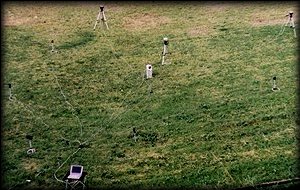 The anomaly logging algorithms developed for Arcadia (as shown on the website) have been completely abandoned and replaced with software that logs long term data at high or low speed sample rates. The reason is simple - as I began studying how data is analyzed and compared in peer reviewed studies, I realized that by ignoring baseline data, you don't have anything to compare your anomalies to. Automatically picking data that have substantially large variations leaves only graphs that are interesting to look at. But, there's no way call that scholarly research with no baseline data or statistics to back it up (but the graphs sure do look good on websites, don't they?).
The anomaly logging algorithms developed for Arcadia (as shown on the website) have been completely abandoned and replaced with software that logs long term data at high or low speed sample rates. The reason is simple - as I began studying how data is analyzed and compared in peer reviewed studies, I realized that by ignoring baseline data, you don't have anything to compare your anomalies to. Automatically picking data that have substantially large variations leaves only graphs that are interesting to look at. But, there's no way call that scholarly research with no baseline data or statistics to back it up (but the graphs sure do look good on websites, don't they?).
So, as stated earlier, all data is logged at a constant rate, normally around 10 hertz for logs of about an hour in length. This data can then be statistically analyzed, so things like standard deviation, Z scores, probability, etc. can be calculated for comparison between haunt and control sites. Not only that, but various forms of digital signal processing can be applied such as FIR or IIR filters to obtain virtually any kind of filtering needed. An adaptive FIR filter could be used, post-logging session, to effectively remove any mathematically predictable components if desired. Discrete Fourier Transforms (DFT's) can also be calculated to view the frequency amplitude spectrum of the data, although a faster sampling rate would be desired (at 10 hertz sampling rate, you'd only be able to analyze frequencies from 0 to 5 hertz).
For the people interested in setting up their own logging units, I highly recommend using the "sample everything" technique, instead of trying to adapt your own baseline filters. That way, statistical comparisons become easy - you can compare haunt and "non-haunt" control sites for standard deviation, calculate probabilities, etc. As for hardware recommendations, National Instruments have many very functional DAQ units available, although you'd have to wire the sensors to it yourself. For common devices (temperature, humidity, etc.) you should be able to find commercial products available. I know of one company - Vernier - that makes A/D converters and several dozen sensors that can be interfaced easily without much knowledge of electronics.
I've gotten a lot of e-mails inquiring about the price of Arcadia, obtaining Arcadia, etc.. Arcadia isn't a product - it is a system I developed to measure environmental data at haunt locations. The techniques used to gather data are not sophisticated by any means, and there are a lot of online resources available for commercial and open-source/design data aquisition products.
Links to DAQ & Sensor Resources:
- National Instruments
- Vernier Software
- PICO Technology
All materials Copyright 2002 - 2009 by JDF of GhostGadgets.com
All Rights Reserved
-
E-mail Webmaster
 The anomaly logging algorithms developed for Arcadia (as shown on the website) have been completely abandoned and replaced with software that logs long term data at high or low speed sample rates. The reason is simple - as I began studying how data is analyzed and compared in peer reviewed studies, I realized that by ignoring baseline data, you don't have anything to compare your anomalies to. Automatically picking data that have substantially large variations leaves only graphs that are interesting to look at. But, there's no way call that scholarly research with no baseline data or statistics to back it up (but the graphs sure do look good on websites, don't they?).
The anomaly logging algorithms developed for Arcadia (as shown on the website) have been completely abandoned and replaced with software that logs long term data at high or low speed sample rates. The reason is simple - as I began studying how data is analyzed and compared in peer reviewed studies, I realized that by ignoring baseline data, you don't have anything to compare your anomalies to. Automatically picking data that have substantially large variations leaves only graphs that are interesting to look at. But, there's no way call that scholarly research with no baseline data or statistics to back it up (but the graphs sure do look good on websites, don't they?).